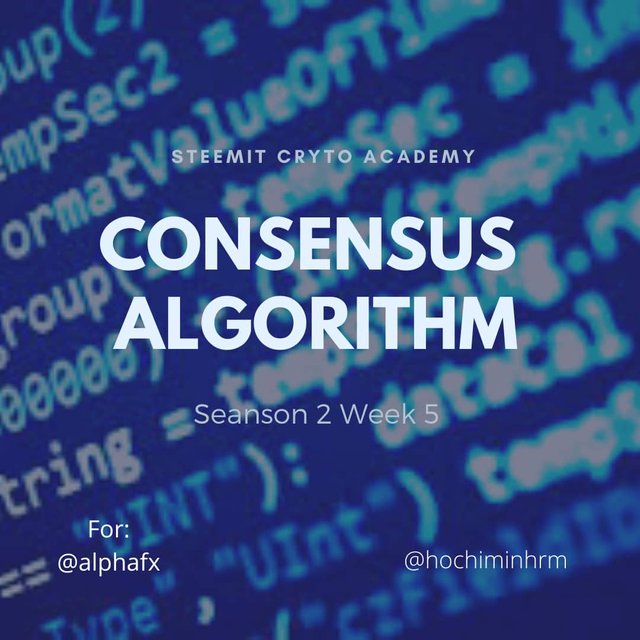SteemitCryptoAcademy: Consensus Algorithms | for @hochiminhrm
Greetings to professor @alphafx for another great conference where week by week we are instructing ourselves in this world of crypto assets, this week we talked about consensus algorithms, the basis of this blockchain technology.

Consensus algorithm
It is a set of specific mathematical rules and laws which are responsible for organizing the work in the blockchain and determine the development for the decision-making of a group.
Consensus algorithms are the technological root of blockchain technology since they play a crucial role in decentralized platforms as it does not have a central entity, the nodes must be brought into line to validate transactions, this is where the consensus algorithm performs its role by ensuring that the protocol rules are complied with and guaranteeing all transactions.
Consensus algorithms are crucial when maintaining the integrity and security of a cryptoactive network, they are responsible for providing the means for distributed nodes to achieve approval regarding the correct version of the blockchain.
The first consensus algorithm created for a crypto asset was Proof of Work (PoW), designed by Satoshi Nakamoto and implemented in bitcoin.

Proof-of-Capacity
This data mining consensus algorithm in which miners arrange their hard drives in order to participate in the verification of operations. In other words, miners calculate and store solutions to mining problems before mining begins.
The capacity test arose to solve the problems of high energy consumption of the proof-of-work (PoW) as well as the problem of the maintenance of cryptocurrencies of the proof-of-stake (PoS) thus giving a more efficient alternative.
Solutions must be created in advance as they are quite complex to perform in real time. In addition, the blocking periods are very short, on average 4 minutes per block if we compare it with those of bitcoin, which are 10 minutes. This is the reason why solutions are stored in advance.
The best way to get rewards is to store most solutions and have them saved on the hard drive in advance, this will increase the possibility that the solution is the fastest. The capacity test is made up of plotting and hard drive mining.
How It Works
The capacity test offers nodes the possibility to use the available space on their hard drives to extract cryptocurrencies. Instead of modifying the numbers in the block header to find the correct hash, a list of possible solutions is established on the hard drive before mining even begins.
While more space is available on the hard disk, it is possible to store more solutions, which increases the possibility of finding the correct hash in order to obtain benefits.
The capability test consists of two components Tracing and Mining.
Path
A list of all possible nonce values is created, these units contain a total of 8,192 hashes numbered from 0 to 8,192. which are paired with each other, combining to form pairs of two. Hash 0 and 1 make up scoop 0 while hash 2 and 3 make up scoop 1, and so on.
Mining
This involves real-time activity, that is, miners must calculate a number of scoops. If a miner starts mining and creates a scoop 38, he must go to scoop 38 of nonce 1 and use all the data from that scoop to calculate the term. This process is constantly repeated until the deadlines of all the nonce saved on the hard disk are known.
A period represents the length of time (seconds) since the last block was created before another miner is allowed to create a new one. If no one else has been able to create a block in that period of time, the miner can create a block and reap the benefits.
Proof-of-Capacity Pros
Proof-of-Capacity mining is much more efficient in electricity consumption compared to Proof-of-work. It is not necessary to incur high equipment and platform expenses as seen in the Bitcoin protocol since the hard drive of your home pc is enough to start mining with this algorithm.
You do not need any special hardware or continuous improvement of hard drives. Mining data can be easily removed, so the disks can be used again to store any type of information.
Cons of Proof-of-Capacity
This algorithm also contains several drawbacks so to speak, it creates a large number of repeated files on the hard drive. The system prioritizes miners with larger storage units, which poses a threat to the concept of decentralization.
This algorithm is not very popular and there is also the possibility that hackers will explore the system infecting the disk with malicious programs.
Used in
SpaceMint: uses a consensus algorithm that is based on a non-interactive variant of the ability test (called the space test).
Permacoin: it reuses the proof of work of bitcoin with a more widely beneficial task, providing a distributed and robust storage.
Burstcoin: it is based on the available space that exists on the hard disk for mining, instead of the CPU and GPU that consume too much electrical fluid.
Conclusion
Consensus algorithms play a fundamental role in the world of the blockchain.They are responsible for ensuring that the nodes are in line in order to validate the transactions and guaranteeing that all protocol rules are met to guarantee all transactions were duly complied with.
The Proof-of-Capacity algorithm or Proof-of-Capacity, in this case miners use storages from their hard drives instead of the more common proof-of-work method, but at the same time much more expensive.




Thanks for participating